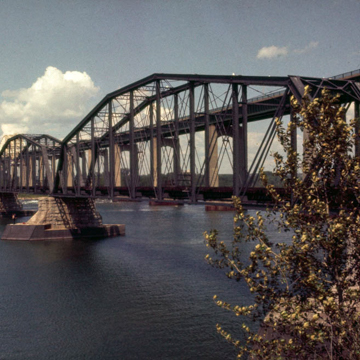Four railroad companies (the Duluth, South Shore and Atlantic; the Minneapolis, St. Paul and Sault Ste. Marie; the Grand Trunk Western; and the Canadian Pacific) collaborated to build the International Railroad Bridge across St. Mary's River. The three builders responsible were J. Reid, who built the substructure; the Dominion Bridge Company of Lachine, Quebec, which underbid all of the American companies because it could import cheap duty-free Scottish steel and could fabricate the structural members in Canada, built the superstructure; and the Detroit Bridge and Iron Works, which built the rest of the bridge crossing the American Navigational Canal. The river section consisted of ten steel camelback through trusses, each 239 feet long, resting on finished ashlar piers, each anchored in the bedrock of the river bottom. One of these trusses was removed in 1913 to enable construction of a new moveable bridge over the American Locks, but nine of the original spans remain. The International Railroad Bridge was the vital west–east connection for Sault Ste. Marie. The growing lake and railroad traffic and the immense waterpower potential that could be harnessed for industry at the Sault precipitated grand predictions that manufacturing and commerce would flourish here.
You are here
International Railroad Bridge, River Section
1887, J. Reid; Dominion Bridge Company; and Detroit Bridge and Iron Works. Over St. Mary's River
If SAH Archipedia has been useful to you, please consider supporting it.
SAH Archipedia tells the story of the United States through its buildings, landscapes, and cities. This freely available resource empowers the public with authoritative knowledge that deepens their understanding and appreciation of the built environment. But the Society of Architectural Historians, which created SAH Archipedia with University of Virginia Press, needs your support to maintain the high-caliber research, writing, photography, cartography, editing, design, and programming that make SAH Archipedia a trusted online resource available to all who value the history of place, heritage tourism, and learning.


